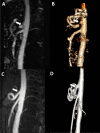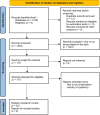Surgical therapy of celiac axis and superior mesenteric artery syndrome
- PMID: 36690823
- PMCID: PMC9870837
- DOI: 10.1007/s00423-023-02803-w
Surgical therapy of celiac axis and superior mesenteric artery syndrome
Abstract
Introduction: Compression syndromes of the celiac artery (CAS) or superior mesenteric artery (SMAS) are rare conditions that are difficult to diagnose; optimal treatment remains complex, and symptoms often persist after surgery. We aim to review the literature on surgical treatment and postoperative outcome in CAS and SMAS syndrome.
Methods: A systematic literature review of medical literature databases on the surgical treatment of CAS and SMAS syndrome was performed from 2000 to 2022. Articles were included according to PROSPERO guidelines. The primary endpoint was the failure-to-treat rate, defined as persistence of symptoms at first follow-up.
Results: Twenty-three studies on CAS (n = 548) and 11 on SMAS (n = 168) undergoing surgery were included. Failure-to-treat rate was 28% for CAS and 21% for SMAS. Intraoperative blood loss was 95 ml (0-217) and 31 ml (21-50), respectively, and conversion rate was 4% in CAS patients and 0% for SMAS. Major postoperative morbidity was 2% for each group, and mortality was described in 0% of CAS and 0.4% of SMAS patients. Median length of stay was 3 days (1-12) for CAS and 5 days (1-10) for SMAS patients. Consequently, 47% of CAS and 5% of SMAS patients underwent subsequent interventions for persisting symptoms.
Conclusion: Failure of surgical treatment was observed in up to every forth patient with a high rate of subsequent interventions. A thorough preoperative work-up with a careful patient selection is of paramount importance. Nevertheless, the surgical procedure was associated with a beneficial risk profile and can be performed minimally invasive.
Keywords: Dunbar; Failure to treat; Median arcuate ligament syndrome; Superior mesenteric artery syndrome; Surgery; Wilkie.
© 2023. The Author(s).
Conflict of interest statement
The authors declare no competing interests.
The authors declare no competing interests.
Figures




References
-
- Harjola PT. A rare obstruction of the coeliac artery. Report of a case. Ann Chir Gynaecol Fenn. 1963;52:547–50. - PubMed
-
- Dunbar JD, Molnar W, Beman FF, Marable SA. Compression of the celiac trunk and abdominal angina. Am J Roentgenol Radium Ther Nucl Med. 1965;95(3):731–744. - PubMed
-
- Merrett ND, Wilson RB, Cosman P, Biankin AV. Superior mesenteric artery syndrome: diagnosis and treatment strategies. J Gastrointest Surg. 2009;13(2):287–292. - PubMed
Publication types
MeSH terms
LinkOut - more resources
Full Text Sources

